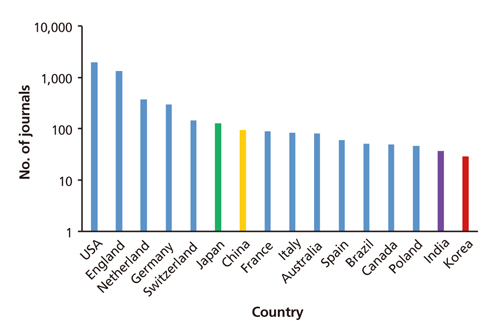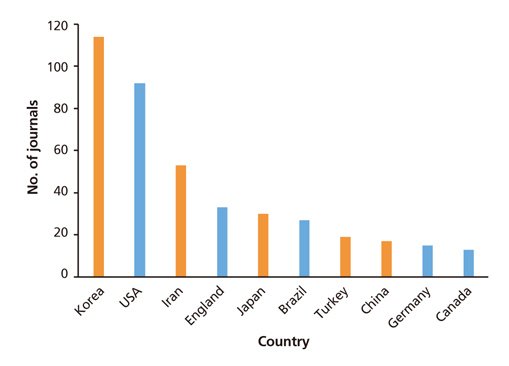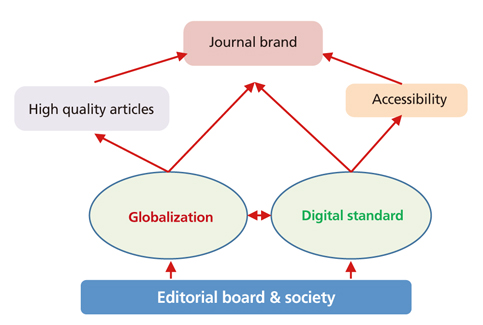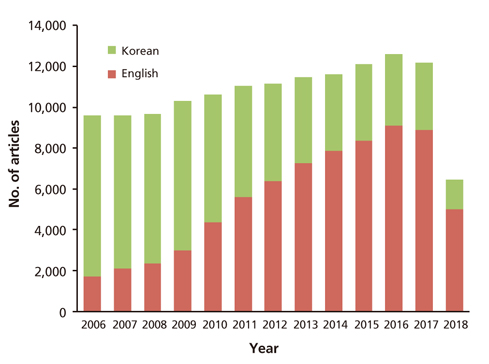J Korean Med Assoc.
2018 Sep;61(9):524-531. 10.5124/jkma.2018.61.9.524.
Recent advances of medical journals in Korea and and further development strategies: Is it possible for them to publish Nobel Prize-winning research?
- Affiliations
-
- 1Department of Parasitology and Institute of Medical Education, College of Medicine, Hallym University, Chuncheon, Korea. shuh@hallym.ac.kr
- KMID: 2420362
- DOI: http://doi.org/10.5124/jkma.2018.61.9.524
Abstract
- Many medical journals from Korea have advanced to the international level since 1996. This study aims to present the current status of Korean medical journals in scholarly literature databases and to suggest strategies for further development. This study focused on the 261 member journals of the Korean Association of Medical Journal Editors (KAMJE). In 2018, 29 journals from Korea were indexed in Medline, of which 22 were KAMJE journals. Since 2008, Korean medical journals have been deposited in PubMed Central. As of 2018, the number of journals deposited in PubMed Central has soared to 116, including 103 KAMJE journals. Ninety KAMJE journals were indexed in Scopus. The average 2017 impact factor of the 40 Science Citation Index Expanded-indexed KAMJE journals was 2.17. Furthermore, 35 journals have been indexed in the Emerging Sources Citation Index. To promote more medical journals to the international level, the following strategies are suggested: first, recruiting high-quality manuscripts with meticulous review and editing; and second, adopting digital standards of scholarly publishing, including full-text XML, to broaden accessibility. Medical journals from Korea have experienced tremendous success in terms of indexing in international literature databases. To promote journals to the highest level, physicians and researchers should be able to read, submit, cite and use the journal articles in a straightforward and diligent manner. With appropriate development strategies, it may be possible for a Nobel Prize to be awarded based on research published in medical journals in Korea in the near future.
Figure
Cited by 1 articles
-
Research Areas and Trends in Articles on Pediatric and Adolescent Tuberculosis in Korea
Ho Yoon Lim, Jung Hyun Lee, Yu Jin Jung, Chi Eun Oh
Pediatr Infect Vaccine. 2019;26(2):89-98. doi: 10.14776/piv.2019.26.2.89.
Reference
-
1. Kim JH, Kim GW, Lee MY, Shin JY, Shin YG, Koh SB, Chung CH. Role of HbA1c in the screening of diabetes mellitus in a Korean rural community. Diabetes Metab J. 2012; 36:37–42.
Article2. Seo JW, Chung H, Seo TS, Jung Y, Hwang ES, Yun CH, Kim H. Equality, equity, and reality of open access on scholarly information. Sci Ed. 2017; 4:58–69.
Article3. Kim S. Congratulations to including in MEDLINE of Korean Journal of Medical Education. Korean J Med Educ. 2015; 27:73.
Article4. Huh S. Promotion to MEDLINE, indexing with Medical Subject Headings, and open data policy for the Journal of Educational Evaluation for Health Professions. J Educ Eval Health Prof. 2016; 13:14.
Article5. Huh S. How to prepare endocrinology and metabolism for reapplication to MEDLINE. Endocrinol Metab. 2017; 32:58–61.
Article6. Huh S. What is the meaning of becoming PubMed Central journal? Korean J Med Educ. 2016; 28:265–267.
Article7. Schwarzman AB. Journal Article Tag Suite subset and Schematron: achieving the right balance. Sci Ed. 2018; 5:2–15.
Article8. Huh S. Adherence of the Annals of Pediatric Endocrinology & Metabolism to the principles of transparency and best practice in scholarly publishing. Ann Pediatr Endocrinol Metab. 2018; 23:1–3.
Article9. Huh S. How to deal with ethical issues involving animal experiments and identifiable photographs in articles published in Archives of Plastic Surgery. Arch Plast Surg. 2017; 44:475–476.
Article10. Huh S. How to successfully list a journal in the Social Science Citation Index or Science Citation Index Expanded. Korean J Med Educ. 2017; 29:221–228.
Article11. Huh S. How to add a journal to the international databases, Science Citation Index Expanded and MEDLINE. Arch Plast Surg. 2016; 43:487–490.
Article12. Huh S. Journal metrics of Clinical and Molecular Hepatology based on the Web of Science core collection. Clin Mol Hepatol. 2018; 24:137–143.
Article13. Chi Y. Scientific publishing in the Asian century: an international perspective. Sci Ed. 2016; 3:112–115.
Article14. Huh S. How much progress has Blood Research made since the change of the journal title in 2013. Blood Res. 2018; 53:95–100.
Article15. Huh S, Choi TJ, Kim SH. Using Journal Article Tag Suite extensible markup language for scholarly journal articles written in Korean. Sci Ed. 2014; 1:19–23.
Article16. Lammey R. CrosssRef tools for small publishers. Sci Ed. 2015; 2:79–85.17. Lammey R. How to apply CrossMark and FundRef via CrossRef extensible markup language. Sci Ed. 2014; 1:84–90.
Article18. Lammey R. CrossRef text and data mining services. Sci Ed. 2015; 2:22–27.
Article19. Im J. Applying Open Researchers and Contributors ID in scholarly journals. Sci Ed. 2015; 2:28–31.
Article20. Chang JH. An introduction to using QR codes in scholarly journals. Sci Ed. 2014; 1:113–117.
Article21. Schmidt HE. Scientific, technical, and medical podcasting in Korea. Sci Ed. 2016; 3:43–48.
Article22. Jeong GH, Huh S. Status of digital standards in Korean medical journals in 2016. Sci Ed. 2016; 3:100–104.
Article23. Yi HJ, Chang JH, Seo YJ. Analysis of the results of the first implementation of the Korea Manuscript Editors Certification. Sci Ed. 2017; 4:34–38.
Article
- Full Text Links
- Actions
-
Cited
- CITED
-
- Close
- Share
- Similar articles
-
- Nobel Prize for Medicine in 1998 : Nitirc Oxide
- Artemisinin and the Nobel Prize in physiology or medicine 2015
- Application of Induced Pluripotent Stem Cells in Rheumatology
- Publishing Ethics and Predatory Practices: A Dilemma for All Stakeholders of Science Communication
- Camillo Golgi (1843 –1926): scientist extraordinaire and pioneer figure of modern neurology






